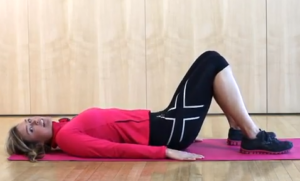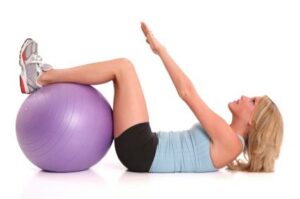Core Exercise for the post partum Mum
When getting back in to exercise after the birth of your child a big focus should be put on the strengthening and repositioning of your abdominal muscles – but only when you are fully recovered.

Your core is more than just the six pack muscle we quite often refer to when we say someone has a ripped core.
In fact, this is the most superficial and perhaps least important muscle to strengthen when you’re looking to get a more functional core, cinch your waist in and tone up or let your separated abs heal. (it’s also the muscle that separates – which is why doing sit-ups until the cows come home to help you lose your baby weight would be a terrible idea and make your rectus abdominus bulge and it could separate even more and is why you should avoid crunches and standard Pilates 100′s).
You should examine yourself to find out what degree of muscle separation you have experienced before undertaking any post partum-exercise (needs to be under 2cm) or receive clearance from your Doctor.
How to examine yourself
Step 1 – In a lying position with knees bent, place your right hand behind your head.
Step 2 – With your left hand position your index finger and middle finger together and place them horizontally in the centreline of your stomach between your abdominals.
Step 3 – From this position slowly raise your head slightly off the floor using your right hand (positioned behind your head) for support. Make sure not to simply lift your head with your hand as this is a common error – you must perform one basic crunch to fully contract your abdominal muscles to get the best assessment of your separation.
Step 4 – Your abdominals will now be slightly contracting allowing you to see exactly how far your abdominals have separated.
Step 5 – If your index finger and middle finger (on your left hand) can still fit between your abdominals you will have Diastasis Recti of between 2 – 2.5cms. For every additional finger you can place inbetween your abdominals you should add 1cm extra to your total abdominal separation number. If you can only fit one finger between your abdominals you effectively have 1cm of separation and will be nearly healed.
If you discover you have more than a 1 – 2cm separation you should refrain from doing exercises such as crunches, sit-ups or pilates 100′s all of which can put too much pressure on the abdominal muscles which have become separated during pregnancy.
Exercises For The Core
Instead, building your core from the inside out and starting with the muscles closest to the bones, is a great idea and is what Pilates can help you focus on. Trying to strengthen your more superficial global muscles is like strengthening the parts of a boat without paying attention to the nuts and bolts. A recipe for disaster.
Once you’ve started working your pelvic floor and know how to draw up rather than bear down, you can start going to work on your building bricks – the transversus abdominus. Using your Hundreds exercise routine (see video below) in a modified version with feet on the floor (and even the head down if you have any neck issues) is a great way to develop initial abdominal endurance.
[pb_vidembed title=”The Hundreds Core Exercise” caption=”” url=”http://www.youtube.com/watch?v=s3wnPqQtTFQ” type=”yt” w=”580″ h=”425″]
The quick movement of the arms challenges your TA, which wraps around the core like a girdle or a kidney belt, to stabilise. The feeling should be more subtle than the bracing sensation you get during a sit-up or oblique twist.
Move on with other simple exercises performed in neutral in a closed kinetic chain – that’s when your feet are on the floor: hiprolls to start strengthening your back body, some leg slides and hip releases. Once you feel confident that you’re able to maintain your core stability and engagement with your feet in the air, try the Hundreds with legs at table top.
Start challenging your obliques – but without twisting just yet. Do single leg lifts and tiny ab pulses instead – never letting the base of the rib cage lift of the floor or the abs bulge at the front. Add in single leg circles. Some side leg work. (See leg lift & hip hover video below).
[pb_vidembed title=”Leg Lift & Hip Hover” caption=”” url=”http://www.youtube.com/watch?v=VU6gLzqhUB0″ type=”yt” w=”580″ h=”425″]
Once you’ve hit this stage, you’re really in a good spot of challenging your core muscles in various ways and working your legs and arms as well. Patience is king but it shouldn’t be too long before you’re able to do stronger exercises. If you have separated abs, err on the side of caution and check in with a physiotherapist or other specialist to make sure it’s safe to start going into flexion and full movement through the core.
[pb_vidembed title=”Pelvic Floor & The Core” caption=”” url=”http://www.youtube.com/watch?v=ix5h6zAUTNs” type=”yt” w=”580″ h=”425″]
For more advice on safe post pregnancy exercises and the pelvic floor click here
This article was written by Sol Walkling, the Lose Baby Weight Pilates Expert and Trainer – to see Sol’s credentials and read more about her click here
More exercises to regain your core & abdominal strength include:
The Four Point Tummy Roll
- Starting on the floor with your hips over your knees and your shoulders over your hands. Keep your spine in a natural alignment, take a deep breath in and let you tummy drop towards the floor
- Now exhale and draw your tummy in toward your spine but remaining in the same position and being careful not to arch your back as you draw in.
- Hold this position for as long as possible with the aim of feeling the Transverse Abdominis Muscle (TVA) working to keep you in this position. The TVA is the muscle behind the Abdominals (6 pack) that cannot be seen, but is the number one muscle that will help you achieve a flat stomach.
- When you can hold no longer and need to breath in simply relax your abdominal wall as you inhale and repeat the exercise 10 – 12 time
Elbow to Knee lifts: Laying flat on a mat/towel
- Gently bring one knee and your opposite elbow together. Then bring your other elbow and knee together. Work up to 20 rep, altering sides.
Pelvic tilts:
- Lie down on the floor with your legs bent, feet resting on the floor. Slowly tighten your abdominals and roll your pelvis towards you. Breathe evenly and try to initiate the movement with your abs instead of squeezing the glutes too much. Don’t forget to tighten the pelvic floor when doing pelvic tilts, since they may place pressure on it and stretch it further.
Isometric Abdominal Contractions:
- This exercise is one that can be done while playing with your baby, making for some wonderful bonding time. Lie on your back with your knees bent and feet flat on the floor. Place your baby on your belly facing you. Take a deep breath in, raising the baby into the air. Exhale as you tighten your abdominal muscle by pulling your belly button in towards the floor. Inhale as you relax and bring the baby down. Repeat eight to ten times.
It is very important to only start exercising after Caesarean section once the doctor has given you the all clear. Due to this procedure impacting severely on all 3 layers of the abdominal wall there needs to be adequate time post pregnancy to allow for the healing process and for the tissue to repair significantly before attempting exercise. As soon as the doctor gives you the all clear to exercise again the core and abdominals are a very important place to start strengthening. A weakness in the core and abdominals post pregnancy has resulted in many new mums experiencing debilitating lower back pain due to weakness when lifting and bending over. As difficult as it might be, you need to be very conscious of lifting and bending after having a Caesarean due to the resultant weakness in your core and abdominal area.
And for the ULTIMATE SAFE, EFFECTIVE & TRUSTED Post Pregnancy Workout – see our EXPERT Post Pregnancy Exercise DVD below – you can purchase and see more information on it here
[pb_vidembed title=”The Post Pregnancy Exercise DVD” caption=”” url=”http://vimeo.com/73423922″ type=”vem” w=”600″ h=”450″]
Please note that this site is for information only and should not replace any medical advice from a Doctor taken before undergoing any weight loss campaign or change in exercise and diet routine post pregnancy and whilst breastfeeding. We also do not recommend any exercise or stomach exercises until you have had full clearance from your Doctor or Physiotherapist post birth – which for mums who have had C-Sections could be many many months post birth and trying to do exercise before you are ready could lead to severe injury.
And don’t forget to check out our current promotions and discounts page to see what specials we have on this week on our Healthy Mummy product range

